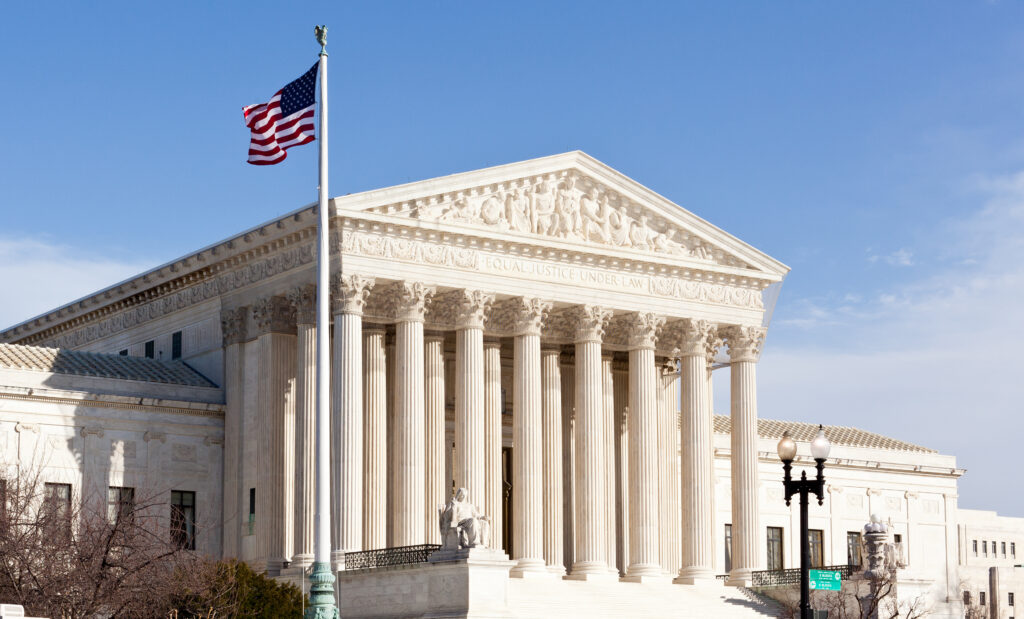Supreme Court Ruling on Texas Abortion Regulations: What Happened and What Now?
*To view as PDF, click here: Supreme Court Ruling on Texas Abortion Regulations
On October 14, 2014, the U.S. Supreme Court issued an order in a federal case involving challenges to abortion-related laws enacted by the State of Texas.
The order comes in a case called Whole Woman’s Health v. Lakey.
In a nutshell, what did the Supreme Court do?
The Supreme Court issued an order that will stop certain abortion laws in Texas from being enforced until the federal courts decide whether those regulations are constitutional.
The Supreme Court did not say whether those laws are constitutional.
What abortion provisions are at issue in this case?
In 2013 the State of Texas enacted legislation known as H.B. 2. The federal court of appeals, Fifth Circuit, has explained that two provisions of H.B. 2 are at issue in this case.
The first provision is known as the admitting privileges provision. This provision “requires any physician performing an abortion to have active admitting privileges at a hospital within thirty miles of the location where the abortion is performed.”
The second provision is known as the ambulatory surgical centers provision. This provision “requires that all abortion clinics existing on or after September 1, 2014, comply with the same minimum standards required of ambulatory surgical centers.”
“The regulatory standards for ambulatory surgical centers contain two main categories: (1) physical plant . . . and (2) operations . . . .” Physical plant “includes architectural, electrical, plumbing, and HVAC requirements” and operations includes “requirements for medical records systems, training, staffing, and cleanliness.”
Does the Supreme Court order mean that the Texas admitting privileges and ambulatory surgical center requirements are unconstitutional?
No. The Supreme Court order means only that the Texas laws covered by the Supreme Court’s order will be temporarily stopped from being enforced until the federal courts determine whether those laws are constitutional.
In this case the district court ruled against the Texas admitting privileges and ambulatory surgical center requirements in various ways. The district court ruling was a ruling on the merits of the laws.
However, the State of Texas has an opportunity to appeal the district court merits decision to the U.S. Court of Appeals for the Fifth Circuit.
And if the Fifth Circuit rules against the admitting privileges requirement or the ambulatory surgical center requirement, or both requirements, then the State of Texas will have an opportunity to appeal the circuit court merits decision to the U.S. Supreme Court.
The State of Texas has already appealed the district court merits decision to the U.S. Court of Appeals for the Fifth Circuit.
However, the Fifth Circuit has not ruled on the merits of the district court decision. So far in this case, the Fifth Circuit has ruled only that, with one exception, the Texas laws challenged in this case should be allowed to go into effect while the Fifth Circuit considers the case.
The Supreme Court order entered on October 14, 2014 addresses only the stay ruling entered by the Fifth Circuit, not the merits of the law. The substance of the challenged law has not been ruled upon, only whether the law will remain in effect on the abortion facilities it applies to while the lawsuit is continuing.
Does this case involve the validity of 20-week laws?
No.
As part of H.B. 2 the State of Texas enacted a provision that, subject to certain exceptions, prohibits abortion of unborn children of 20 or more weeks post-fertilization age.
The 20-week law was not challenged in this lawsuit and the Supreme Court order issued on October 14, 2014 has nothing to do with the validity of that law.
Does this case involve the validity of regulations governing the practice of medication abortion?
No, at least not directly.
As part of H.B. 2 the State of Texas enacted a health and safety law that, subject to exception, requires abortion-inducing drugs to be administered in accordance with “the protocol tested and authorized by the United States Food and Drug Administration as outlined in the final printed label of the abortion-inducing drug.” The law also imposes other health and safety requirements for administering abortion-inducing drugs.
In this case the plaintiffs have not challenged specific regulations governing the use of abortion-inducing drugs. Therefore, the validity of those regulations is not at issue in this case.
In fact, the U.S. Court of Appeals for the Fifth Circuit has already upheld the FDA-protocol requirement in a previous challenge to that provision of H.B. 2.
However, this case does indirectly involve the practice of medication abortion. That’s because the plaintiffs have challenged the ambulatory surgical center provision of H.B. 2 as applied to the practice of medication abortion.
The district court enjoined the ambulatory surgical center provision as applied to medication abortions.
The Fifth Circuit entered a stay pending appeal as to that part of the district court’s order.
The order entered by the U.S. Supreme Court states, “The Court of Appeals’ stay order with reference to the district court’s order enjoining the ambulatory surgical center requirement is vacated.”
Although the Fifth Circuit addressed other issues involving the ambulatory surgical center requirement—not just the application of that requirement to the practice of medication abortion—the Supreme Court order could be interpreted as encompassing all elements of the Fifth Circuit’s stay order addressing the ambulatory surgical center requirement in any way.
Therefore it is possible (and perhaps likely) that, under the Supreme Court order, the ambulatory surgical center requirements of Texas law will not apply for now to the practice of medication abortion.
However, a ruling on the merits (i.e., constitutionality) of applying the ambulatory surgical center requirements to medication abortions has not been issued in this case by either the Fifth Circuit or the Supreme Court.
And the validity of the regulations specifically governing the administration of abortion-inducing drugs (such as the requirement that they be administered according to the FDA-approved protocol) is not at issue at all in this case.
How does this case relate to the earlier litigation involving Texas abortion laws enacted as part of H.B. 2?
This is not the first case challenging abortion laws enacted by Texas in 2013 as part of H.B. 2.
As the Fifth Circuit wrote in its stay opinion, “We are familiar with legal challenges to H.B. 2. In 2013, the district court enjoined enforcement of H.B. 2’s admitting privileges requirement and medication abortion provision, and the State challenged the injunction on appeal. . . . In that case,” the Fifth Circuit writes, “we granted in part the State’s emergency motion to stay the permanent injunction . . . and later upheld both the admitting privileges requirement and the medication abortion provision as facially constitutional . . . .”
That case was called Planned Parenthood of Greater Texas Surgical Health Services v. Abbott. That case was a big win for women in Texas and for the pro-life cause in general.
The Fifth Circuit goes on to explain that, in this second case, which is titled Whole Woman’s Health v. Lakey, the plaintiffs “challenge the admitting privileges requirement, this time not on its face, but as applied to two specific clinics. . . [:] the clinic operated by Whole Woman’s Health in McAllen. . . . [and] the clinic operated by Reproductive Services in El Paso.” The Fifth Circuit explains that “Plaintiffs also challenge the ambulatory surgical center provision as unconstitutional on its face, and as applied to the clinics in McAllen and El Paso, and as applied to medication abortion.”
Unlike in the earlier case, Planned Parenthood, “the largest provider of abortion services in Texas” and nationwide, is not a party in this case.
Briefly, what are the key court rulings leading up to the U.S. Supreme Court order issued on October 14?
On August 29, 2014 the federal district court in this case enjoined enforcement of certain provisions of H.B. 2, an abortion bill enacted in 2013 by the State of Texas.
The State of Texas asked the U.S. Court of Appeals for the Fifth Circuit to “stay” the district court order until the Fifth Circuit ruled on the merits of the laws.
In a revised opinion dated October 8, 2014, a three-judge panel of the Fifth Circuit agreed to stay the order of the district court with one exception. This would have allowed the laws covered by the stay order to be enforced during the appeal.
On October 6, 2014, the plaintiff abortion providers challenging the Texas law asked the Supreme Court to vacate the stay entered by the Fifth Circuit, thereby rendering the abortion facility regulations inoperative until the case is finally resolved.
On October 14, 2014 the Supreme Court agreed to vacate parts of the stay order entered by the Fifth Circuit.
What happens next?
The U.S. Court of Appeals for the Fifth Circuit will consider the merits of the appeal from the district court order.
The Fifth Circuit has issued an “expedited cross appeal schedule.” Under the schedule the final brief is due on December 8, 2014. Oral argument has not yet been scheduled.
Once the Fifth Circuit rules on the merits, one or more parties likely will seek review by the Supreme Court. In the meantime, the Texas abortion facilities affected by the Texas law, 13 of which indicated they would be forced to close if the ambulatory surgical centers and admitting privileges regulations were upheld, will remain open for business.
Thomas M. Messner is Senior Fellow in Legal Policy at the Charlotte Lozier Institute.






















